
An Australian success story, until Apple came along and steamrollered
the Microbee market with the Apple ][. So far I've discovered that the company
was originally Applied Technology with one Owen Hill at the helm. The first
Microbees were sold as kits along the same lines as the Compukit UK101 and would've
been originally uncased. Not many of these are known to exist.
After that however, things moved apace. The machines gained popularity
in Austrialian schools, and estimates have eventual sales in the hundreds of
thousands. 'Bees were also sold to Swedish schools (20% at one point), and were
also used, according to a 1986 interview with Owen Hill, in a lot of European
car manufacturers who had factories in Australia.
Single board design with not-unattractive 2-tone 3 piece case,
the later original 'bees started at 16K and went up to (according to the box
I've got here) 64K. After that Microworld entered the CP/M market with a 56K
twin drive Microbee and produced what was known as the 'chook in a book' - a
Microbee in an aluminium case built to resemble a book with, apparently, the
world's noisiest 3.5" drive :)
The 128K 'Premium' was a very popular machine, housed in an identical
case to the 32K 'bee but with cursor keys down next to the spacebar. The last
Microbee was the TC256 which was aimed at the school market, but by that time
Apple had got their foot in the door. Pity, the TC256 seemed like a cross between
a laptop and an Amiga with its keypad and built-in 3.5" floppy....certainly
if you google for Microbee you'll get people's fond memories of the TC256.
They had one machine in the pipeline that would've been a groundbreaker
if it had got out; aimed at the Sun workstation market, the Gamma featured a
Motorola 68000 CPU as well as twin Z80s, one of which did graphics processing.
Only a handful of finished machines are known to exist, so that's my chance
of getting one out of the window :)
Here's a mail from Michael Leys:
"The DIN plug on the back of the machine has the following
connections.
Pin Connection
1. Power supply - +8.5 to 10 volts (lower is better - machine runs cooler
as regulators don't have to dump so much power)
2. GND or 0 Volts
3. Cassette SAVE (to AUX or MIC on cassette recorder)
4. Video output.
5. Cassette LOAD (to Earphone jack on cassette recorder)"
1. Power supply - +8.5 to 10 volts (lower is better - machine runs cooler
as regulators don't have to dump so much power)
2. GND or 0 Volts
3. Cassette SAVE (to AUX or MIC on cassette recorder)
4. Video output.
5. Cassette LOAD (to Earphone jack on cassette recorder)"
"I think the early Microbees used a 10 volt 1 ampere plug pack which worked
ok but got a bit on the warm side so the later ones were rated at 1.5
amperes. Why they were 10 volt and not lower I don't know - probably
because they thought a bit more was better and more stable. In their disk
machines, microbee used a switch mode power supply with three outlets each
having +5 and +12 volts. They then used diode bridges wired as "resistors"
to drop the 12 volts to 10 or so. A favouite mod was to use a second bridge
in series to further lower the input to the regulators and so make things
run cooler."
ok but got a bit on the warm side so the later ones were rated at 1.5
amperes. Why they were 10 volt and not lower I don't know - probably
because they thought a bit more was better and more stable. In their disk
machines, microbee used a switch mode power supply with three outlets each
having +5 and +12 volts. They then used diode bridges wired as "resistors"
to drop the 12 volts to 10 or so. A favouite mod was to use a second bridge
in series to further lower the input to the regulators and so make things
run cooler."
Smart - thanks Michael! He also said that since my machine came from Sweden it's going to have Swedish ROMs. Oh well, they're socketed so replacement with English ones should be easy.
Update 3/8/03
Finally got round to making the 'grey cable' up for the machines using a DIN plug, half an RCA audio lead and some speaker cable, and as you can see at least one of the machines is happy! The Swedish ROMs appear to be for the keyboard encoding and chargen only, so that's good intit.
Machines
Microbee 32, aka Microbee II, boxed but with no PSU or 'grey cable'
to connect everything up.
Pictures
 | 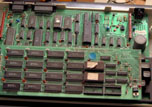 | 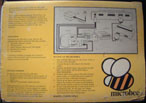 | 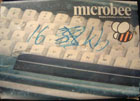 |
 |  | 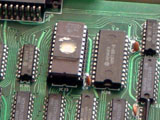 |  |
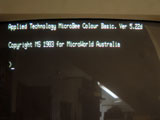 | 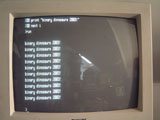 | 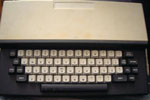 |  |